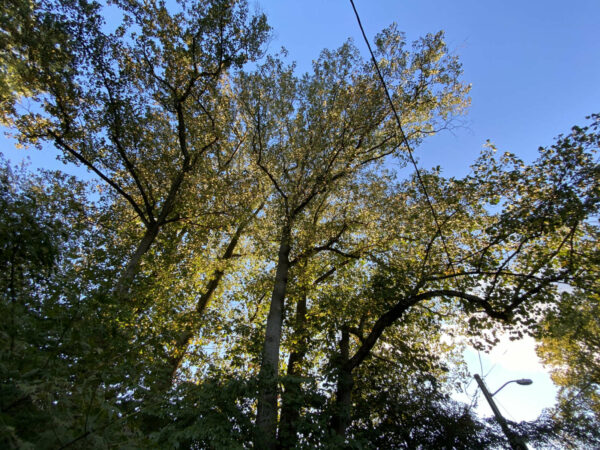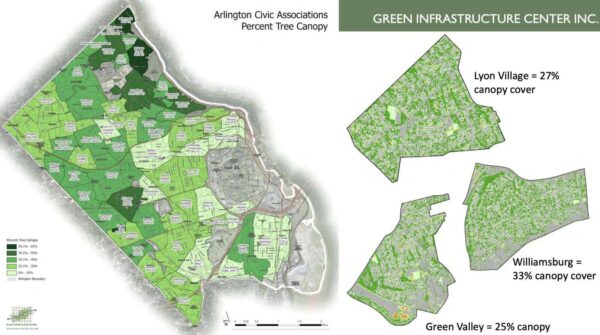
EcoAction Arlington just got a $60,000 boost from the Arlington branch of the NAACP and the Mormon church in its efforts to plant trees in disadvantaged neighborhoods.
Last year, the environmental advocacy group announced its plan to plant trees in 10 neighborhoods where the canopy is thinner than elsewhere — areas generally less wealthy and more diverse than Arlington’s leafier enclaves. The 2022 announcement coincided with a $50,000 donation from Amazon.
The initiative, dubbed the Tree Canopy Equity program, aims to raise $1.5 million to fund planting 250 trees twice a year, for the next five years — or 2,500 trees total. Last week, the NAACP announced it had selected EcoAction Arlington to receive the money through a strategic grant and partnership with The Church of Jesus Christ of Latter-day Saints.
“Arlington has a 10-year life expectancy difference amongst its neighborhoods, and this donation will create focus and provide much-needed tree canopy in places that have, for decades, been left out of the conversation,” NAACP Branch President Michael Hemminger said in a statement. “For years, EcoAction Arlington has been a committed partner in the furtherance of our mission, making them a natural fit for why we selected this non-profit as the recipient.”
To date, EcoAction Arlington has raised $239,000 from individuals, corporations, nonprofits, foundations and the state of Virginia, executive director Elenor Hodges tells ARLnow.
“That’s got to be a record for us in most money raised in shortest amount of time,” she said. “We’re truly grateful to the NAACP and looking to them as a true partner.”
The money funds outreach needed to find residents, apartment buildings and organizations interested in planting trees. It also pays for shrubs — trees are paid for through the Arlington County Tree Canopy Fund — and, in some cases, water.
Hodges says she is excited to use support from a foundation to pay community members to do the outreach work, similar to a model used in Wards 7 and 8 in D.C.
“This community work takes people, time and money, so we want to pay people and professionalize it,” she said.
This spring, volunteers planted 215 trees and 110 shrubs across the 10 neighborhoods, particularly in Penrose, Green Valley and Aurora Highlands, she said. Shrubs provide the benefits of trees and are ideal for people without the space for a tree or who are not ready to add one to their yard.
The 10 neighborhoods being targeted have a lower average tree canopy than Arlington County as a whole, according to one study funded by some members of local environmental advocacy groups, including EcoAction Arlington.
Based on imaging from 2021, a consultant found that trees cover 33% of land — excluding the Pentagon and Reagan National Airport — down from 41% on the same land six years ago. The 10 neighborhoods, meanwhile, have a canopy coverage average of 22.6%.
The neighborhoods and their canopy levels are as follows:
- Arlington View, 17%
- Aurora Highlands, 22%
- Buckingham, 21%
- Columbia Heights, 28%
- Glebewood, 29%
- Green Valley, 24%
- John M. Langston Citizens Association, 19%
- Long Branch Creek, 24%
- Penrose, 23%
- Radnor/Fort Myer Heights, 19%

The absence of trees makes a neighborhood hotter and Arlington’s hottest places are along the Rosslyn-Ballston corridor and near Reagan National Airport, per a study by Marymount University.
Study authors say this is because concrete and asphalt absorb heat and radiate it back into the environment while neighborhoods in North Arlington have more trees and gardens to soak up that sunshine.
Nationally, many of these “heat islands” are also in previously redlined neighborhoods, according to one study on which NPR reported.
Last century, the federal government used race demographics to suggest risky and safe places to lend money for mortgages. “High-risk” areas were outlined in red and today, these areas have higher temperatures, according to the study.
“There’s outstanding research in last couple years that perfectly overlays heat islands and red lined places,” Julie Rosenberg with the Arlington hub of Faith Alliance for Climate Solutions previously told ARLnow. “They’re living in much hotter neighborhoods and that heat has a huge impact on their quality of life.”
Residents of areas with less tree canopy end up paying more for electricity to run air conditioning units that tend to be worse quality and potentially growing mold, she continued.
On hot days, people will spend more time indoors with the AC on, potentially exposing themselves to mold and the health impacts that follow from it.
“It’s a cascade,” she said. “This is so well-documented now about the inequities around heat.”
In its press release, the NAACP also said trees play an important role filtering pollutants and harmful particles from the air. Thus, neighborhoods with fewer trees can have higher pollution levels that can also cause asthma.
“Black communities are almost three times more likely to die from asthma-related causes and this donation is an important step forward in helping to right many wrongs of the past,” the group said.

